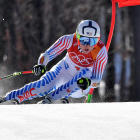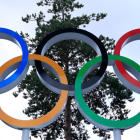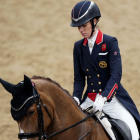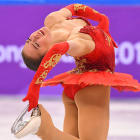Alpine skiing is a little weird. You've got all of these different names and all of these different disciplines. What's a slalom? How does combined work? And what in the world is super-G? Here's what you need to know about skiing: They're going really fast, the biggest different in disciplines is how technical they need to be to go faster.
However, alpine skiing is just an umbrella moniker. At the Winter Olympics, five different disciplines fall in the alpine skiing category: Slalom, giant slalom, super-G, downhill and the combined. Among these five events, slalom and giant slalom are "technical" disciplines, while super-G and downhill are "speed" events. The combined, meanwhile, is an alpine biathlon of sorts, in which racers must show off their technical skill-set in the slalom and their penchant for dangerous downhill speeds.
With all of that in mind, there are very different rules and techniques that go into all five disciplines. There are 13 total Alpine events: six for men, six for women and one mixed.
Men's alpine
- Alpine combined men
- Downhill men
- Giant slalom men
- Slalom men
- Super combined men
- Super-G men
Women's alpine
- Alpine combined women
- Downhill women
- Giant slalom women
- Slalom women
- Super Combined women
- Super-G women
Mixed alpine
- Parallel mixed team event
Here's a look at each of the five disciplines -- plus what goes into the combined.
Slalom
Slalom features the shortest course of any of the disciplines, so naturally it makes sense to start there. A technical discipline, slalom has "gates" (the sets of poles along the course) that skiers must ski between. The gates are set extremely close together, so it requires quick, tight turns to do well. As we all know, the fastest path between two points is a straight line, meaning that skiers try to minimize how much they have to turn to get through each gate. In doing so, you'll see skiers hit the gates with their hands or shins to get them out of the way. Slalom looks like chaos on the course, what with the strange alignment to the poles, but it's fast and technical, lending to its appeal.
Giant slalom
Giant slalom is like slalom, but BIGGER. It has different gates from slalom, with two poles conjoined by flags rather than one. There are different colors. Racers must find a path through one color. The turns are bigger than slalom, making finding a path that much more essential.
Scoring in technical disciplines
The scoring here is pretty simple. Each skier gets two runs, with the first run's start being determined by both draw and World Cup ranking. After that, the field is whittled down to 30 skiers -- who go in reverse order from their time in the first run. The reason for this is to level the playing field. Think about hockey, and how the ice gets worn as a period goes on. The same thing happens in a slalom course. There are more bumps, the ground isn't as smooth, and it ultimately impacts time. In the end, the times from each run are added up -- with the shortest time being the winner.
Downhill
Downhill is, in a word, insane. It doesn't take much explaining, mind you. Skiers start really high up on a very steep drop and must complete a course that is as close to straight as you'll get in an Alpine discipline. Runs are quick here, and speed is of the essence. Skiers can hit speeds surpassing 80 mph while flying down the course. It isn't devoid of technical skill -- there are semblances of turns to be made -- but this discipline is all about getting to the bottom and then figuring out how the heck to stop.
Super-G
Super-G is like downhill lite. You're still trying to get the bottom as quickly as possible, but it's a shorter course and the turns are tighter. Athletes often end up turning their bodies into the ground on super-G runs, as they're making tight turns at incredible speeds. With that in mind, it's downhill with a twist -- it's reliant on patience and knowing where on the course to speed up as much as it's about technical skill and the ability to accelerate.
The combined
The combined is just like it sounds: a combination of slalom and downhill. A traditional combined competition consists of one run of downhill and two runs of slalom -- and the skier with the fastest combined time wins. It's a true test of alpine skiing, since often skiers specialize in one racing form or another.
A course set has just as much to do with the results as slope. Alpine skiing is of the few disciplines at the Winter Games that requires thorough reconnaissance before a run can even be made. It's extremely challenging as Olympians try to make their way to the bottom. There's also weather to consider, which has already played a factor in this year's Olympics.
Finally, equipment presents a key component of these races. The general rule is that longer skis elongate the turn radius and increase speed. There's always a rub. So shorter skis will allow for tighter turns, but they can also reduce the speed on straightaways.
There is one more event, and it's a parallel team event. There are two giant slaloms next to each other, and racers of the same gender race side-by-side. It's a heat format, and the winner of each heat advances to the next round.
There are all sorts of challenges presented by downhill skiing. Whether it's the course, the skill component, the speed component, having the wrong skis that day -- any number of variables can affect the result of the race. Just ask Bode Miller, who'll be calling races on NBC. Add in that racers must know when to tuck (put their poles at their sides and coast) or glide, and it becomes even more challenging. You can see alpine skiing throughout the Olympics, with the men finally set to take the course on Monday night at 8 p.m. for the downhill run of the combined. You can also see the full Olympics TV schedule by clicking this link.
















